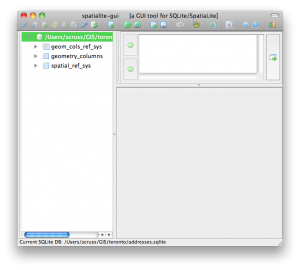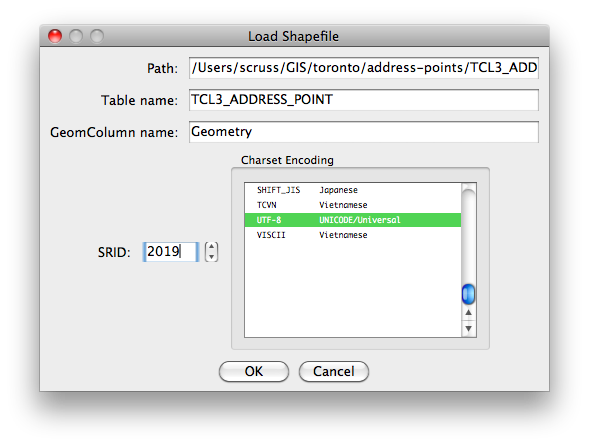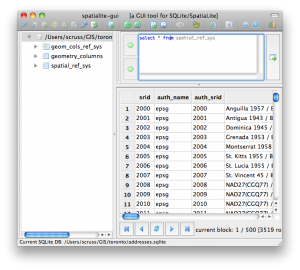I’m going to use SpatiaLite and the Toronto One Address Repository to try some simple geocoding. That is, given an address, spit out the real-world map coordinates. As it happens, the way the Toronto data is structured it doesn’t really need to use any GIS functions, just some SQL queries. There are faster and better ways to code this, but I’m just showing you how to load up data and run simple queries.
SpatiaLite is my definition of magic. It’s an extension to the lovely SQLite database that allows you to work with spatial data – instead of selecting data within tables, you can select within polygons, or intersections with lines, or within a distance of a point.
I’m going to try to avoid having too many maps here, as maps are a snapshot of a particular view of a GIS at a certain time. Maps I can make; GIS is what I’m trying to learn.
So, download the data and load up SpatiaLite GUI. Here I’ve created a new database file. addresses.sqlite. I’m all ready to load the shapefile.
 Shapefiles are messy things, and are definitely glaikit. Firstly, they’re a misnomer; a shapefile is really a bunch of files which need to be kept together. They’re also a really old format; the main information store is actually a dBaseIII database. They also have rather dodgy ways of handling projection metadata. For all their shortcomings, no-one’s come up with anything better that people actually use.
Shapefiles are messy things, and are definitely glaikit. Firstly, they’re a misnomer; a shapefile is really a bunch of files which need to be kept together. They’re also a really old format; the main information store is actually a dBaseIII database. They also have rather dodgy ways of handling projection metadata. For all their shortcomings, no-one’s come up with anything better that people actually use.
Projection information is important, because the world is inconveniently unflat. If you think of a projected X-Y coordinate system as a graph paper Post-It note stuck to a globe, the grid squares depend on where you’ve decided to stick the note. Also, really only the tiny flat part that’s sticking to the globe closely approximates to real-world coordinates.
Thankfully, the EPSG had a handle on all this projection information (and, likely, Post-It notes). Rather than using proprietary metadata files, they have a catalogue of numbers that exactly identify map projections. SpatiaLite uses these Spatial Reference System Identifiers (SRIDs) to keep different projections lined up.
Toronto says its address data is in ‘MTM 3 Degree Zone 10, NAD27’. That’s not a SRID. You can list all the SRIDs that SpatiaLite knows with:
select * from spatial_ref_sys
which returns over 3500 results.
As we know there’s an MTM (Modified Transverse Mercator) and a 27 in the title, we can narrow things down:
select srid,ref_sys_name from spatial_ref_sys where ref_sys_name like '%MTM%' and ref_sys_name like '%27%'
The results are a bit more manageable:
| srid | ref_sys_name |
|---|---|
| 2017 | NAD27(76) / MTM zone 8 |
| 2018 | NAD27(76) / MTM zone 9 |
| 2019 | NAD27(76) / MTM zone 10 |
| 2020 | NAD27(76) / MTM zone 11 |
| 2021 | NAD27(76) / MTM zone 12 |
| 2022 | NAD27(76) / MTM zone 13 |
| 2023 | NAD27(76) / MTM zone 14 |
| 2024 | NAD27(76) / MTM zone 15 |
| 2025 | NAD27(76) / MTM zone 16 |
| 2026 | NAD27(76) / MTM zone 17 |
| 32081 | NAD27 / MTM zone 1 |
| 32082 | NAD27 / MTM zone 2 |
| 32083 | NAD27 / MTM zone 3 |
| 32084 | NAD27 / MTM zone 4 |
| 32085 | NAD27 / MTM zone 5 |
| 32086 | NAD27 / MTM zone 6 |
So it looks like 2019 is our SRID. That last link goes to spatialreference.org, who maintain a handy guide to projections and SRIDs. (Incidentally, Open Toronto seems to use two different projections for its data – the other is ‘UTM 6 Degree Zone 17N NAD27’ with a SRID of 26717.)
So let’s load it:
 This might take a while, as there are over 500,000 points in this data set.
This might take a while, as there are over 500,000 points in this data set.
If you want to use this data along with more complex geographic queries, add a Spatial Index by right-clicking on the Geometry table and ‘Build Spatial Index’. This will take a while again, and make the database file quite huge (128MB on my machine).
Update: there’s a much quicker way of doing this without messing with invproj in this comment.
Now we’re ready to geocode. I was at the Toronto Reference Library today, which is at 789 Yonge Street. Let’s find that location:
select easting, northing, address, lf_name, name, fcode_desc from TCL3_ADDRESS_POINT where lf_name like 'yonge%' and address=789
which gives:
| EASTING | NORTHING | ADDRESS | LF_NAME | NAME | FCODE_DESC |
|---|---|---|---|---|---|
| 313923.031 | 4836665.602 | 789 | YONGE ST | Toronto Reference | Library |
(for most places, NAME and FCODE_DESC are blank.)
Ooooh … but those coordinates don’t look anything like the degrees we had yesterday. We have to convert back to unprojected decimal degrees with my old friend, proj. If we store the northing, easting and a label in a file, we can get the get the geographic coordinates with:
invproj -E -r -f "%.6f" +proj=tmerc +lat_0=0 +lon_0=-79.5 +k=0.9999 +x_0=304800 +y_0=0 +ellps=clrk66 +units=m +no_defs < file.txt
which gives us:
4836665.602000 313923.031000 -79.386869 43.671824 Library
Now that’s more like it: 43.671824°N, 79.386869°W. On a map, that’s:
Pretty close, eh?
Incidentally, I didn’t just magic up that weird invproj line. Most spatial databases use proj to convert between projections, and carry an extra column with the command line parameters. For our SRID of 2019, we can call it up with this:
select proj4text from spatial_ref_sys where srid=2019;
which returns:
+proj=tmerc +lat_0=0 +lon_0=-79.5 +k=0.9999 +x_0=304800 +y_0=0 +ellps=clrk66 +units=m +no_defs
Update: there’s a much better way of invoking invproj. It understands EPSG SRIDs, so we could have done:
invproj -E -r -f "%.6f" +init=EPSG:2019 < file.txt


8 replies on “a simple geocoder for toronto”
[…] and Catherine are quite partial to libraries. I’m going to use the address points database we made yesterday to find the libraries within 2km of a given address. It’s not a very useful […]
There’s a much quicker way to do this:
select astext(transform(geometry,4326)), address, lf_name, name, fcode_desc from TCL3_ADDRESS_POINT where lf_name like ‘yonge%’ and address=789;
which returns:
POINT(-79.386869 43.671824)|789|YONGE ST|Toronto Reference|Library
This actually uses the geometry of the point as opposed to stored fields. transform(…, 4326) transforms the CRS to WGS84.
How would you get the property dimensions from that data. Any sample query?
I don’t think you can. These are just address points. You’d need the lot data, which is not open in Ontario.
you’re saying that you can’t somehow add X and Y to the Lat and Lng?
I have no idea what you mean by that comment.
This data set might be what you are looking for: Property Boundaries. Spatial join it to the address points, and you should be good.
Sorry, that is the data set I was referring to. I’ve loaded it all into a local mysql db.
I have very little experience with this and am looking for a sample query. Would you be able to provide one?
Columns :
X = Easting, in MTM NAD 27(3 degree) Projection
Y = Northing, in MTM NAD 27(3 degree) Projection
LONGITUDE = Longitude in WGS84 Coordinate System
LATITUDE = Latitude in WGS84 Coordinate System
X & Y, and Latitude & Longitude, are just points. The same points. In different coordinate systems. Mixing them would make no sense.
I can’t give you a sample query, as a) I don’t know what you want, and b) This sounds like paid work. My rates are reasonable.